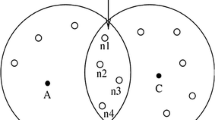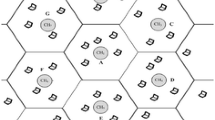Abstract
Mobile ad hoc networks are in widespread use in the recent years due to their infrastructureless dynamic topology, ease of deployment and the ability of the nodes to be mobile, making them more defenceless to attacks. Provisioning secure communications between nodes in such a hostile environment is a major concern. Hence, nodes are issued certificates as a means of conveying trust that only nodes with valid certification can function in the network. In our work, we aim to revoke the certificates of malicious nodes from the network warranting a risk-less communication. To facilitate an accurate and an efficient certificate revocation, we propose a reliant model, wherein every node is associated with reliance, which is a measure of its goodness. The model, not only merits good behaviour, but also punishes any misbehaviour. When the node is perceived to be unreliable, by at least more than half of the neighbouring nodes, an accusation packet is forwarded to the Certificate Authority whereby the certificate of the accused node is cancelled thus enabling a reliable multihop transmission. The performance measures of the proposed model are compared with the previous revocation techniques. Results demonstrate that the proposed scheme is effective than the existing schemes.










Similar content being viewed by others
References
Kannhavong, B., Nakayama, H., Nemoto, Y., & Kato, N. (2007). A survey of routing attacks in mobile ad-hoc networks. IEEE Wireless Communications, 14(5), 85–91.
Yu, M., Zhou, M., & Su, W. (2009). A secure routing protocol against byzantine attacks for MANETs in adversarial environments. IEEE Transactions on Vehicular Technology, 58(1), 449–460.
El Defraw, K., & Tsudik, G. (2011). Privacy-preserving locationbased on-demand routing in MANETs. IEEE Journal on Selected Areas in Communications, 29(10), 1926–1934.
Abbas, S., Merabti, M., Llewellyn-Jones, D., & Kifayat, K. (2013). Light weight Sybil attack detection in MANETs. IEEE Systems Journal, 7(2), 236–248.
Yoo, Y., & Agrawal, D. P. (2006). Why does it pay to be selfish in a MANET? IEEE Wireless Communications, 13(6), 87–97.
Louta, M., Michalas, A., & Kraounakis, S. (2002). A survey on reputation-based cooperation enforcement schemes in wireless ad-hoc networks. IEEE/ACM symposium on mobile ad-hoc networking and computing, MobiHoc.
Shi1, F., & Song, J. (2012). A cluster-based countermeasure against media aces control layer atacks in IEEE 802.11 ad hoc networks. KSII transactions on internet and information systems, Vol. 6, NO. 6, pp. 1565–1585, June, 2012.
Shakshuki, E. M., Kang, N., & Sheltami, T. R. (2013). EAACK-A secure intrusion detection system for MANET. IEEE Transactions on Industrial Electronics, 60(3), 1089–1098.
Mohammed, N. Otrok, H., Wang, L. Y., Debbabi, M., & Bhattacharya, P. (2011). Mechanism design-based secure leader election model for intrusion detection in MANETs. IEEE Transactions on Dependable and Secure Computing, 8(1), 89–103.
Anantvalee, T., & Wu, J. (2012). Reputation-based system for encouraging the cooperation of nodes in mobile ad-hoc networks. In Proceedings of computer science and information technology, Vol. 36, pp. 3383–3388, April, 2012.
Chinni, S., Thomas, J., Ghinea, G., & Shen, Z. (2008). Trust model for certificate revocation in ad-hoc networks. Ad-hoc Networks, Elsevier Publications, 6(3), 441–457.
Sadamate, S. S., & Nandedkar, V. S. (2013). Review on calculation, distribution of trust and reputaion in MANETs. International Journal of Science and Modern Engineering (IJISME ), 1(6), 83–88.
Li, Z., & Shen, H. (2011). Hierarchical account-aided reputation management system for large-scale MANETs. In Proceedings of IEEE INFOCOM, pp. 909–917, April 10–15, 2011.
Dhurandher, S. K., Obaidat, M. S., Verma, K., Gupta, P., & Dhurandher, P. (2011). FACES: Friend-based ad-hoc routing using challenges to establish security in MANET systems. IEEE Systems Journal, 5(2), 176–188.
Park, K., Nishiyama, H., Ansari, N., & Kato, N. (2010). Certificate revocation to cope with false accusations in mobile ad-hoc networks. 71st IEEE Conference on vehicular Technology, VTC, pp. 1–5, May 16–19, 2010.
Panke, T. R. (2013). Clustering based certificate revocation scheme for malicious nodes in MANETs. International Journal of Scientific and Research Publications, 3(5), 1–5.
Gan, C., Mata-Daz, J., Muoz, J. L., Hernndez-Serrano, J., Esparza, O., & Alins, J. (2012). A modelling of certicate revocation and its application to synthesis of revocation trace. IEEE Transactions on Information Forensics and Security, 7(6), 1623–1686.
Harn, L., & Ren, J. (2011). Generalized digital certificate for user authentication and key establishment for secure communications. IEEE Transactions On Wireless Communications, 10(7), 2372–2379.
Arboit, G., Cre‘peau, C., Davis, C. R. & Maheshwaran, M. (2008). A localized certificate revocation scheme for mobile ad hoc networks. Ad hoc networks (Vol. 6, Issue. 1). New York: Elsevier Publications.
Luo, J., Hubaux, J., & Eugster, P. (2005). Dictate: Distributed certification authority with probabilistic freshness for ad-hoc networks. IEEE Transactions on Dependable and Secure Computing, 2(4), 311–323.
Srividya, M., Radhika, K., & Jamuna, D. (2012). Review on certificate revocation of mobile ad-hoc networks. International Journal of Engineering Research and Technology (IJERT), 1(7), 1–4.
Eichler, S., & Muller-Rathgeber, B. (2005). Performance analysis of scalable certificate revocation schemes for ad-hoc networks. In Proceedings of 30 th anniversary, IEEE conference on local computer networks, pp. 340–391, November 17, 2005.
Iliadisa, J., Gritzalisa, S., Spinellisb, D., De Cockc, D., Preneelc, B., & Gritzalis, D. (2003). Towards a framework for evaluating certificate status information mechanisms. Computer Communications, Elsevier Publications, 26(16), 1839–1850.
Luo, H., Kong, J., Songwu, L., Petros, Z., & Zhang, L. (2004). URSA: Ubiquitous and robust access control for mobile ad hoc networks. IEEE/ACM Transactions on Networking, 12(6), 1049–1063.
Clulow, J., & Moore, T. (2006). Suicide for the common good: A new strategy for credential revocation in self-organizing systems. ACM SIGOPS Operating Systems Review, 40(3), 18–21.
Liu, W., Nishiyama, H., Yang, N. A. J., & Kato, N. (2013). Cluster-based certificate revocation with vindication capability for mobile ad-hoc networks. IEEE Transactions on Parallel and Distributed Systems, 24(2), 239–249.
Author information
Authors and Affiliations
Corresponding author
Rights and permissions
About this article
Cite this article
Raja, K., Deivasigamani, A. & Ravi, V. A Reliant Certificate Revocation of Malicious Nodes in MANETs. Wireless Pers Commun 90, 435–455 (2016). https://doi.org/10.1007/s11277-015-3016-8
Published:
Issue Date:
DOI: https://doi.org/10.1007/s11277-015-3016-8




